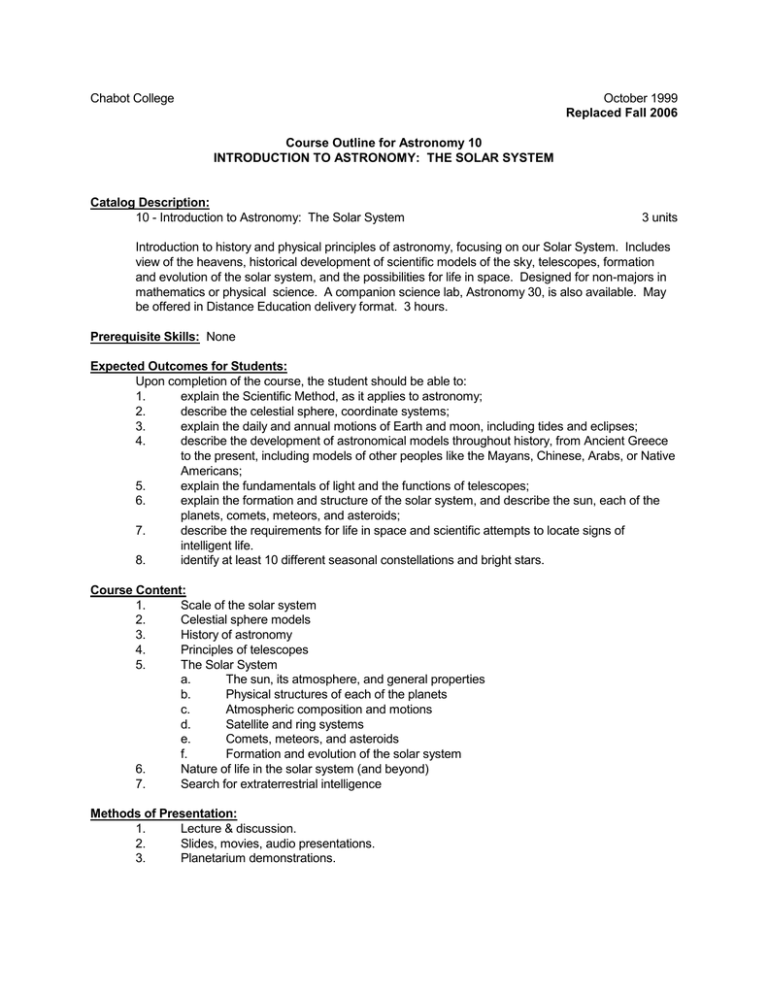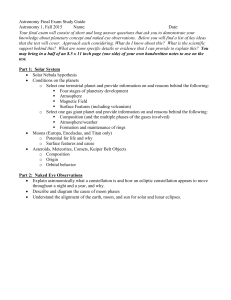Chabot College October 1999 Replaced Fall 2006
advertisement

Chabot College October 1999 Replaced Fall 2006 Course Outline for Astronomy 10 INTRODUCTION TO ASTRONOMY: THE SOLAR SYSTEM Catalog Description: 10 - Introduction to Astronomy: The Solar System 3 units Introduction to history and physical principles of astronomy, focusing on our Solar System. Includes view of the heavens, historical development of scientific models of the sky, telescopes, formation and evolution of the solar system, and the possibilities for life in space. Designed for non-majors in mathematics or physical science. A companion science lab, Astronomy 30, is also available. May be offered in Distance Education delivery format. 3 hours. Prerequisite Skills: None Expected Outcomes for Students: Upon completion of the course, the student should be able to: 1. explain the Scientific Method, as it applies to astronomy; 2. describe the celestial sphere, coordinate systems; 3. explain the daily and annual motions of Earth and moon, including tides and eclipses; 4. describe the development of astronomical models throughout history, from Ancient Greece to the present, including models of other peoples like the Mayans, Chinese, Arabs, or Native Americans; 5. explain the fundamentals of light and the functions of telescopes; 6. explain the formation and structure of the solar system, and describe the sun, each of the planets, comets, meteors, and asteroids; 7. describe the requirements for life in space and scientific attempts to locate signs of intelligent life. 8. identify at least 10 different seasonal constellations and bright stars. Course Content: 1. Scale of the solar system 2. Celestial sphere models 3. History of astronomy 4. Principles of telescopes 5. The Solar System a. The sun, its atmosphere, and general properties b. Physical structures of each of the planets c. Atmospheric composition and motions d. Satellite and ring systems e. Comets, meteors, and asteroids f. Formation and evolution of the solar system 6. Nature of life in the solar system (and beyond) 7. Search for extraterrestrial intelligence Methods of Presentation: 1. Lecture & discussion. 2. Slides, movies, audio presentations. 3. Planetarium demonstrations. Chabot College Course Outline for Astronomy 10, Page 2 October 1999 Typical Assignments: 1. Reading assignments 2. Optional term papers 3. Homework exercises Methods of Evaluating Student Progress: The student’s final grade will be made on the basis of: 1. Quiz averages 2. Homework averages 3. Examination results 4. Optional term papers Textbook(s) (Typical): Astronomy The Evolving Universe, Zelik, 1998 Special Student Materials: SH/hp 2/94 a:ASTRO10CO.CON None




